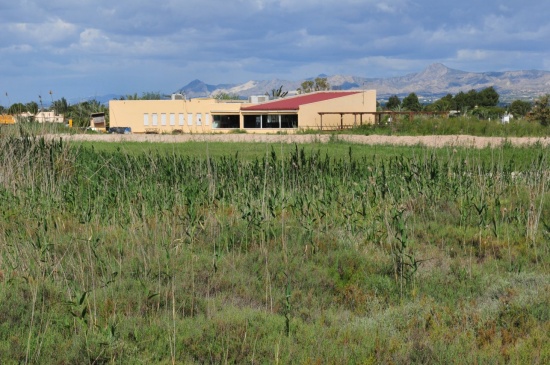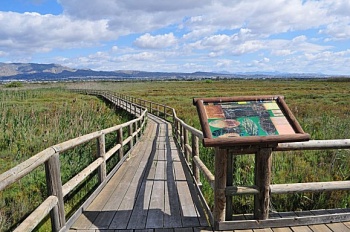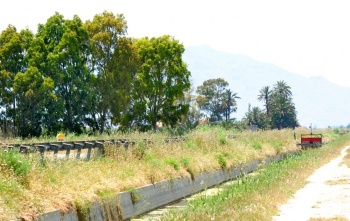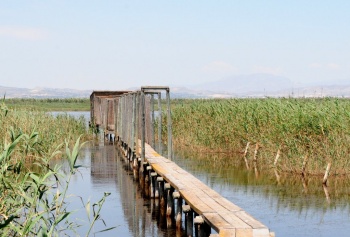Nutcracker (talk | contribs) m (link corrected) |
|||
| (13 intermediate revisions by 4 users not shown) | |||
| Line 2: | Line 2: | ||
'''[[Europe]], [[Spain]]''' | '''[[Europe]], [[Spain]]''' | ||
==Overview== | ==Overview== | ||
| + | |||
The Parque Natural de El Hondo de Elche – also confusingly known (and signposted) as El Fondo d’Elx in the Valenciano dialect – is a nature park which is on the RAMSAR wetlands convention list and classified as a special protection area for birds, or ZEPA. The park is of international importance as both a breeding area for rare and endangered species, and also a wintering and migration site. It is part of an area which used to be known as Elche Lagoon, which was almost completely drained from the 18th Century onwards. The area lies to the southwest of Elche in the province of Alicante, and is 2,387 hectares in size. | The Parque Natural de El Hondo de Elche – also confusingly known (and signposted) as El Fondo d’Elx in the Valenciano dialect – is a nature park which is on the RAMSAR wetlands convention list and classified as a special protection area for birds, or ZEPA. The park is of international importance as both a breeding area for rare and endangered species, and also a wintering and migration site. It is part of an area which used to be known as Elche Lagoon, which was almost completely drained from the 18th Century onwards. The area lies to the southwest of Elche in the province of Alicante, and is 2,387 hectares in size. | ||
Today there are two main irrigation reservoirs, Poniente and Levante which are 650 and 450 hectares respectively, around which are a series of ponds and salt marshes, surrounded by fields and palm plantations which together form an area which repays frequent watching all year round. | Today there are two main irrigation reservoirs, Poniente and Levante which are 650 and 450 hectares respectively, around which are a series of ponds and salt marshes, surrounded by fields and palm plantations which together form an area which repays frequent watching all year round. | ||
| + | |||
==Birds== | ==Birds== | ||
===Notable Species=== | ===Notable Species=== | ||
| Line 11: | Line 13: | ||
Image:Marbled.jpg|<br />A pair of Marbled Ducks <br />{{user|Mark+Etheridge|Mark Etheridge}}<br />El Hondo, May 2010 | Image:Marbled.jpg|<br />A pair of Marbled Ducks <br />{{user|Mark+Etheridge|Mark Etheridge}}<br />El Hondo, May 2010 | ||
</gallery> | </gallery> | ||
| − | Winter brings an impressive number of raptors to the area, [[Marsh Harrier]], [[Booted Eagle]], [[Common Buzzard]] and [[Osprey]] are regular, also rarities such as [[Lanner Falcon]], [[Black-shouldered Kite]] and [[Red-footed Falcon]] have been recorded, whilst "Tonn" the Estonian satellite-tracked [[Greater Spotted Eagle]] arrived again | + | Winter brings an impressive number of raptors to the area, [[Marsh Harrier]], [[Booted Eagle]], [[Common Buzzard]] and [[Osprey]] are regular, also rarities such as [[Lanner Falcon]], [[Black-shouldered Kite]] and [[Red-footed Falcon]] have been recorded, whilst "Tonn" the Estonian satellite-tracked [[Greater Spotted Eagle]] arrived again in Autumn 2016 for his ninth consecutive winter there, he has now been fitted with a new satellite transmitter this summer after the previous one failed. In December 2010 there were no less than five Greater Spotted Eagles overwintering. |
There are large breeding colonies of Herons, including the Grey, Purple, Squacco and Black-crowned Night Heron. Nesting duck species include Common and Red-crested Pochard, Shelduck, Mallard, while other birds of interest include Collared Pratincole, Bearded and Penduline Tit, Glossy Ibis and Whiskered Tern. In 2013 a pair of [[Osprey]] bred successfully. | There are large breeding colonies of Herons, including the Grey, Purple, Squacco and Black-crowned Night Heron. Nesting duck species include Common and Red-crested Pochard, Shelduck, Mallard, while other birds of interest include Collared Pratincole, Bearded and Penduline Tit, Glossy Ibis and Whiskered Tern. In 2013 a pair of [[Osprey]] bred successfully. | ||
| Line 19: | Line 21: | ||
===Rarities=== | ===Rarities=== | ||
| − | Rarities have occurred with considerable frequency at El Hondo. Highlights have included [[Dotterel]], [[Red-throated Pipit]], [[Lesser Flamingo]], [[Brent Goose]], [[Ferruginous Duck]], [[Pectoral Sandpiper]] and [[Isabelline Shrike]]. | + | Rarities have occurred with considerable frequency at El Hondo. Highlights have included [[Eurasian Dotterel]], [[Red-throated Pipit]], [[Lesser Flamingo]], [[Brent Goose]], [[Ferruginous Duck]], [[Pectoral Sandpiper]] and [[Isabelline Shrike]]. |
===Check-list=== | ===Check-list=== | ||
| − | {{BirdsSee|[[Little Grebe]], [[Great Crested Grebe]], [[Black-necked Grebe]], [[Little Bittern]], [[Black-crowned Night Heron]], [[Squacco Heron]], [[Cattle Egret]], [[Little Egret]], [[Grey Heron]], [[Purple Heron]], [[White Stork]], [[Glossy Ibis]], [[Eurasian Spoonbill]], [[Greater Flamingo]], [[Common Shelduck]], [[Eurasian Wigeon]], [[Common Teal]], [[Mallard]], [[Northern Pintail]], [[Garganey]], [[Northern Shoveler]], [[White-headed Duck]], [[Marbled Duck]], [[Red-crested Pochard]], [[Common Pochard]], [[Tufted Duck]], [[Western Marsh | + | {{BirdsSee|[[Little Grebe]], [[Great Crested Grebe]], [[Black-necked Grebe]], [[Little Bittern]], [[Black-crowned Night Heron]], [[Squacco Heron]], [[Cattle Egret]], [[Great Egret]], [[Little Egret]], [[Grey Heron]], [[Purple Heron]], [[White Stork]], [[Glossy Ibis]], [[Eurasian Spoonbill]], [[Greater Flamingo]], [[Common Shelduck]], [[Eurasian Wigeon]], [[Common Teal]], [[Mallard]], [[Northern Pintail]], [[Garganey]], [[Northern Shoveler]], [[White-headed Duck]], [[Marbled Duck]], [[Red-crested Pochard]], [[Common Pochard]], [[Tufted Duck]], [[Western Marsh Harrier]], [[Montagu's Harrier]], [[Booted Eagle]], [[Osprey]], [[Common Kestrel]], [[Common Quail]], [[Water Rail]], [[Common Moorhen]], [[Eurasian Coot]], [[Western Swamphen]], [[Black-winged Stilt]], [[Pied Avocet]], [[Stone Curlew]], [[Collared Pratincole]], [[Little Ringed Plover]], [[Ringed Plover]], [[Kentish Plover]], [[Eurasian Golden Plover]], [[Grey Plover]], [[Northern Lapwing]], [[Little Stint]], [[Curlew Sandpiper]], [[Dunlin]], [[Ruff]], [[Common Snipe]], [[Black-tailed Godwit]], [[Bar-tailed Godwit]], [[Whimbrel]], [[Eurasian Curlew]], [[Spotted Redshank]], [[Common Redshank]], [[Common Greenshank]], [[Marsh Sandpiper]], [[Green Sandpiper]], [[Wood Sandpiper]], [[Common Sandpiper]], [[Arctic Skua]], [[Little Gull]], [[Mediterranean Gull]], [[Black-headed Gull]], [[Yellow-legged Gull]], [[Slender-billed Gull]], [[Common Tern]], [[Little Tern]], [[Whiskered Tern]], [[Gull-billed Tern]], [[Black Tern]], [[Rock Dove]], [[European Turtle Dove]], [[Common Cuckoo]], [[Common Swift]], [[Alpine Swift]], [[Pallid Swift]], [[Common Kingfisher]], [[European Bee-eater]], (PM), [[Eurasian Hoopoe]], [[Roller]], [[Eurasian Wryneck]], [[Greater Short-toed Lark]], [[Lesser Short-toed Lark]], [[Crested Lark]], [[Thekla Lark]], [[Eurasian Crag Martin]], [[Barn Swallow]], [[Northern House Martin]], [[Meadow Pipit]], [[Water Pipit]], Spanish [[Yellow Wagtail]], [[White Wagtail]], [[Bluethroat]], [[Common Nightingale]], [[Eurasian Robin]], [[Black Redstart]], [[Common Redstart]], [[Whinchat]], [[European Stonechat]], [[Northern Wheatear]], [[Black-eared Wheatear]], [[Black Wheatear]], [[Blue Rock Thrush]], [[Cetti's Warbler]], [[Zitting Cisticola]], [[Savi's Warbler]], [[Moustached Warbler]], [[Eurasian Reed Warbler]], [[Great Reed Warbler]], [[Sardinian Warbler]], [[Spectacled Warbler]], [[Blackcap]], [[Wood Warbler]], [[Common Chiffchaff]], [[Willow Warbler]], [[Spotted Flycatcher]], [[European Pied Flycatcher]], [[Bearded Tit]], [[Penduline Tit]], [[Southern Grey Shrike]], [[Woodchat Shrike]], [[Eurasian Jackdaw]], [[Common Starling]], [[Spotless Starling]], [[House Sparrow]], [[Chaffinch]], [[European Serin]], [[European Greenfinch]], [[European Goldfinch]], [[Eurasian Linnet]], [[Reed Bunting]], [[Corn Bunting]]}} |
| − | [[Image:VistabellaRd.jpg|thumb|350px| | + | [[Image:VistabellaRd.jpg|thumb|350px|right|<br />{{user|John+.B.+Oliver|John Oliver}}<br />The view back along the canal path to the bridge on the Vistabella Road]] |
==Other Wildlife== | ==Other Wildlife== | ||
| Line 33: | Line 35: | ||
It should be noted that there are occasional disagreements with the local farmers about the provision of irrigation water to the surrounding land - this has led to closure of the reserve and some ill-feeling towards the reserve status of the area. At the time of writing (May 2010) the problem had been resolved, but it may resurface during any future drought conditions. | It should be noted that there are occasional disagreements with the local farmers about the provision of irrigation water to the surrounding land - this has led to closure of the reserve and some ill-feeling towards the reserve status of the area. At the time of writing (May 2010) the problem had been resolved, but it may resurface during any future drought conditions. | ||
| − | A dam and irrigation pipework have been constructed to the south of the reserve in order to prevent the drying | + | A dam and irrigation pipework have been constructed to the south of the reserve in order to prevent the drying out of the larger lakes, and provide a system to flush out excess salt and debris from the area. This has improved water levels throughout the reserve. |
[[Image:Boardwalk.jpg|thumb|350px|right|<br />{{user|John+.B.+Oliver|John Oliver}}<br />The boardwalk through the reeds to the Reserva Integral hide at El Hondo]] | [[Image:Boardwalk.jpg|thumb|350px|right|<br />{{user|John+.B.+Oliver|John Oliver}}<br />The boardwalk through the reeds to the Reserva Integral hide at El Hondo]] | ||
| Line 41: | Line 43: | ||
The nearby city of Elche is famous for its Palm Trees in the Municipal Park and the nearby "Huerto del Cura" (Priest's Garden). Fiestas are held throughout the year, with various processions and fireworks displays - see the local press for details. Accommodation, shops and restaurants are plentiful throughout the area. | The nearby city of Elche is famous for its Palm Trees in the Municipal Park and the nearby "Huerto del Cura" (Priest's Garden). Fiestas are held throughout the year, with various processions and fireworks displays - see the local press for details. Accommodation, shops and restaurants are plentiful throughout the area. | ||
| − | The Crevillent mountain range to the north of El Hondo is well-known as a nesting site for [[Bonelli's Eagle]] and [[Eagle Owl]] as well as other montane species. | + | The Crevillent mountain range to the north of El Hondo is well-known as a nesting site for [[Bonelli's Eagle]] and [[Eagle Owl]] as well as other montane species. [[Image:ElHondo_Crevillente.jpg|thumb|350px|right|<br />{{user|lazza|Andrew Lamb}}<br />A view of El Hondo from a Vistabella Road hide, with Serra de Crevillente in the background]] |
===Access and Facilities=== | ===Access and Facilities=== | ||
| − | Access to El Hondo is strictly controlled in most areas, but there are access points around the site and guided tours within the reserve itself which must be booked in advance, either by calling at the Information Centre (well signposted from nearby San Felipe Neri) or by phoning on 966 678 515 where the staff will inform you of the visiting timetable. From the Information Centre, there is also a short boardwalk route across some | + | Access to El Hondo is strictly controlled in most areas, but there are access points around the site and guided tours within the reserve itself which must be booked in advance, either by calling at the Information Centre (well signposted from nearby San Felipe Neri) or by phoning on 966 678 515 where the staff will inform you of the visiting timetable. From the Information Centre, there is also a short boardwalk route across some newly-created pools, but this route is open on a daily basis with no need to book beforehand. Further areas between the two main pools are now open to visitors, there are two hides which can be accessed from the end of the boardwalk, and a further walk to the west takes you to another good viewpoint. |
| − | The Information Centre itself is a modern building with a large parking area; wheelchair access is very good and there is a limited catering facility with drinks and snacks available, and also toilets. There is a large display (in Spanish) about the reserve, and a large picture window overlooks a | + | The Information Centre itself is a modern building with a large parking area; wheelchair access is very good and there is a limited catering facility with drinks and snacks available, and also toilets. There is a large display (in Spanish) about the reserve, and a large picture window overlooks a pond which can give views of the birds without leaving the centre. This area contains the [[Red-knobbed Coot]]s which are the subject of a reintroduction programme. The staff at the centre can speak some English, and are very helpful. There is also a substantial picnic area outside where the Sparrows will bother you for crumbs! |
The road skirting the southern edge of the reserve (the Vistabella Road) is a very good birdwatching area both for the reserve itself and the farm fields to the south which often hold birds of interest such as raptors, various species of lark, and during the winter months flocks of Common Cranes are regular. There are three hides available here; the first is a recently-renovated hide overlooking a smaller lake called the Reserva Integral which is always open - it is accessed via a small concrete bridge over the canal alongside the road, then a short walk eastwards along the canal until you find a bridge across the inner canal and a short walk through the reedbeds - this is signposted. A further walk 500 metres eastwards will bring you to a second hide accessed by a longer boardwalk through the reeds. A third hide is situated 500 metres further on to the east, and most of the species found in the main reserve area can be observed from these hides, all best visited in the morning when the sun is behind you. | The road skirting the southern edge of the reserve (the Vistabella Road) is a very good birdwatching area both for the reserve itself and the farm fields to the south which often hold birds of interest such as raptors, various species of lark, and during the winter months flocks of Common Cranes are regular. There are three hides available here; the first is a recently-renovated hide overlooking a smaller lake called the Reserva Integral which is always open - it is accessed via a small concrete bridge over the canal alongside the road, then a short walk eastwards along the canal until you find a bridge across the inner canal and a short walk through the reedbeds - this is signposted. A further walk 500 metres eastwards will bring you to a second hide accessed by a longer boardwalk through the reeds. A third hide is situated 500 metres further on to the east, and most of the species found in the main reserve area can be observed from these hides, all best visited in the morning when the sun is behind you. | ||
| Line 63: | Line 65: | ||
*[http://www.turismedelx.com/en/naturaleza The tourist information website of Elche has a good section on wildlife in the area] | *[http://www.turismedelx.com/en/naturaleza The tourist information website of Elche has a good section on wildlife in the area] | ||
*[http://maps.google.co.uk/maps?f=q&source=s_q&hl=en&geocode=&q=El+Hondo,+Elche,+Espa%C3%B1a&sll=38.182262,-0.758034&sspn=0.134124,0.22007&ie=UTF8&hq=&hnear=El+Hondo,+Spain&z=12 El Hondo on Google Maps] | *[http://maps.google.co.uk/maps?f=q&source=s_q&hl=en&geocode=&q=El+Hondo,+Elche,+Espa%C3%B1a&sll=38.182262,-0.758034&sspn=0.134124,0.22007&ie=UTF8&hq=&hnear=El+Hondo,+Spain&z=12 El Hondo on Google Maps] | ||
| + | |||
| + | {{GSearch|El_Hondo}} | ||
| + | <br /> | ||
| + | {{Video|El_Hondo}} | ||
''Content and images originally posted by Mark Etheridge'' | ''Content and images originally posted by Mark Etheridge'' | ||
<!-- --> | <!-- --> | ||
| − | [[Category:Spain]] [[Category:Locations]] | + | [[Category:Spain]] [[Category:Locations]] [[Category:Videos]] |
Revision as of 17:20, 22 July 2017
Overview
The Parque Natural de El Hondo de Elche – also confusingly known (and signposted) as El Fondo d’Elx in the Valenciano dialect – is a nature park which is on the RAMSAR wetlands convention list and classified as a special protection area for birds, or ZEPA. The park is of international importance as both a breeding area for rare and endangered species, and also a wintering and migration site. It is part of an area which used to be known as Elche Lagoon, which was almost completely drained from the 18th Century onwards. The area lies to the southwest of Elche in the province of Alicante, and is 2,387 hectares in size.
Today there are two main irrigation reservoirs, Poniente and Levante which are 650 and 450 hectares respectively, around which are a series of ponds and salt marshes, surrounded by fields and palm plantations which together form an area which repays frequent watching all year round.
Birds
Notable Species
El Hondo is particularly famous as one of the main breeding areas for two endangered species, the White-headed Duck and the Marbled Teal or Marbled Duck.
Male White-headed Duck
Mark Etheridge
El Hondo, May 2010
A pair of Marbled Ducks
Mark Etheridge
El Hondo, May 2010
Winter brings an impressive number of raptors to the area, Marsh Harrier, Booted Eagle, Common Buzzard and Osprey are regular, also rarities such as Lanner Falcon, Black-shouldered Kite and Red-footed Falcon have been recorded, whilst "Tonn" the Estonian satellite-tracked Greater Spotted Eagle arrived again in Autumn 2016 for his ninth consecutive winter there, he has now been fitted with a new satellite transmitter this summer after the previous one failed. In December 2010 there were no less than five Greater Spotted Eagles overwintering.
There are large breeding colonies of Herons, including the Grey, Purple, Squacco and Black-crowned Night Heron. Nesting duck species include Common and Red-crested Pochard, Shelduck, Mallard, while other birds of interest include Collared Pratincole, Bearded and Penduline Tit, Glossy Ibis and Whiskered Tern. In 2013 a pair of Osprey bred successfully.
Attempts are being made to reintroduce Red-knobbed Coot to the reserve, with birds brought in from Valencia in 2012 on a possible captive breeding programme. These are easily seen from the main Visitor Centre which overlooks a newly-constructed pool where the Coots are.
Rarities
Rarities have occurred with considerable frequency at El Hondo. Highlights have included Eurasian Dotterel, Red-throated Pipit, Lesser Flamingo, Brent Goose, Ferruginous Duck, Pectoral Sandpiper and Isabelline Shrike.
Check-list
Birds you can see here include:
Little Grebe, Great Crested Grebe, Black-necked Grebe, Little Bittern, Black-crowned Night Heron, Squacco Heron, Cattle Egret, Great Egret, Little Egret, Grey Heron, Purple Heron, White Stork, Glossy Ibis, Eurasian Spoonbill, Greater Flamingo, Common Shelduck, Eurasian Wigeon, Common Teal, Mallard, Northern Pintail, Garganey, Northern Shoveler, White-headed Duck, Marbled Duck, Red-crested Pochard, Common Pochard, Tufted Duck, Western Marsh Harrier, Montagu's Harrier, Booted Eagle, Osprey, Common Kestrel, Common Quail, Water Rail, Common Moorhen, Eurasian Coot, Western Swamphen, Black-winged Stilt, Pied Avocet, Stone Curlew, Collared Pratincole, Little Ringed Plover, Ringed Plover, Kentish Plover, Eurasian Golden Plover, Grey Plover, Northern Lapwing, Little Stint, Curlew Sandpiper, Dunlin, Ruff, Common Snipe, Black-tailed Godwit, Bar-tailed Godwit, Whimbrel, Eurasian Curlew, Spotted Redshank, Common Redshank, Common Greenshank, Marsh Sandpiper, Green Sandpiper, Wood Sandpiper, Common Sandpiper, Arctic Skua, Little Gull, Mediterranean Gull, Black-headed Gull, Yellow-legged Gull, Slender-billed Gull, Common Tern, Little Tern, Whiskered Tern, Gull-billed Tern, Black Tern, Rock Dove, European Turtle Dove, Common Cuckoo, Common Swift, Alpine Swift, Pallid Swift, Common Kingfisher, European Bee-eater, (PM), Eurasian Hoopoe, Roller, Eurasian Wryneck, Greater Short-toed Lark, Lesser Short-toed Lark, Crested Lark, Thekla Lark, Eurasian Crag Martin, Barn Swallow, Northern House Martin, Meadow Pipit, Water Pipit, Spanish Yellow Wagtail, White Wagtail, Bluethroat, Common Nightingale, Eurasian Robin, Black Redstart, Common Redstart, Whinchat, European Stonechat, Northern Wheatear, Black-eared Wheatear, Black Wheatear, Blue Rock Thrush, Cetti's Warbler, Zitting Cisticola, Savi's Warbler, Moustached Warbler, Eurasian Reed Warbler, Great Reed Warbler, Sardinian Warbler, Spectacled Warbler, Blackcap, Wood Warbler, Common Chiffchaff, Willow Warbler, Spotted Flycatcher, European Pied Flycatcher, Bearded Tit, Penduline Tit, Southern Grey Shrike, Woodchat Shrike, Eurasian Jackdaw, Common Starling, Spotless Starling, House Sparrow, Chaffinch, European Serin, European Greenfinch, European Goldfinch, Eurasian Linnet, Reed Bunting, Corn Bunting
Other Wildlife
There are some interesting fish species in the lagoons and pools, including Mullet, Eels and the "Fartet" or Spanish Pupfish which is endemic to the area, along with the Freshwater Shrimp providing a food source for the Flamingoes and other birds. The most common lizard species is the Red-tailed Lizard.
Site Information
History and Use
What was once the Elche lagoon disappeared due to both the natural silting up of the land and drainage operations; the need for a supply of fresh water to clear the salts from the surrounding farmlands and to irrigate the crops led to the construction of the two main reservoirs, with the surrounding banks creating the swamp areas which have been colonised by extensive reed beds.
It should be noted that there are occasional disagreements with the local farmers about the provision of irrigation water to the surrounding land - this has led to closure of the reserve and some ill-feeling towards the reserve status of the area. At the time of writing (May 2010) the problem had been resolved, but it may resurface during any future drought conditions.
A dam and irrigation pipework have been constructed to the south of the reserve in order to prevent the drying out of the larger lakes, and provide a system to flush out excess salt and debris from the area. This has improved water levels throughout the reserve.
Areas of Interest
El Hondo is within a short drive of Cabo de Santa Pola which includes the Santa Pola Salinas, the Clot de Galvany reserve by Gran Alacant and the El Pinet reserve at La Marina. It is less than half an hour's drive from Alicante Airport.
The nearby city of Elche is famous for its Palm Trees in the Municipal Park and the nearby "Huerto del Cura" (Priest's Garden). Fiestas are held throughout the year, with various processions and fireworks displays - see the local press for details. Accommodation, shops and restaurants are plentiful throughout the area.
The Crevillent mountain range to the north of El Hondo is well-known as a nesting site for Bonelli's Eagle and Eagle Owl as well as other montane species.
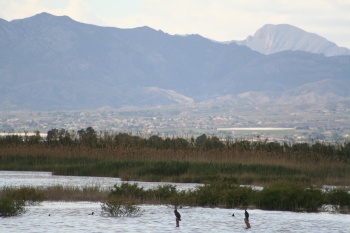
Andrew Lamb
A view of El Hondo from a Vistabella Road hide, with Serra de Crevillente in the background
Access and Facilities
Access to El Hondo is strictly controlled in most areas, but there are access points around the site and guided tours within the reserve itself which must be booked in advance, either by calling at the Information Centre (well signposted from nearby San Felipe Neri) or by phoning on 966 678 515 where the staff will inform you of the visiting timetable. From the Information Centre, there is also a short boardwalk route across some newly-created pools, but this route is open on a daily basis with no need to book beforehand. Further areas between the two main pools are now open to visitors, there are two hides which can be accessed from the end of the boardwalk, and a further walk to the west takes you to another good viewpoint.
The Information Centre itself is a modern building with a large parking area; wheelchair access is very good and there is a limited catering facility with drinks and snacks available, and also toilets. There is a large display (in Spanish) about the reserve, and a large picture window overlooks a pond which can give views of the birds without leaving the centre. This area contains the Red-knobbed Coots which are the subject of a reintroduction programme. The staff at the centre can speak some English, and are very helpful. There is also a substantial picnic area outside where the Sparrows will bother you for crumbs!
The road skirting the southern edge of the reserve (the Vistabella Road) is a very good birdwatching area both for the reserve itself and the farm fields to the south which often hold birds of interest such as raptors, various species of lark, and during the winter months flocks of Common Cranes are regular. There are three hides available here; the first is a recently-renovated hide overlooking a smaller lake called the Reserva Integral which is always open - it is accessed via a small concrete bridge over the canal alongside the road, then a short walk eastwards along the canal until you find a bridge across the inner canal and a short walk through the reedbeds - this is signposted. A further walk 500 metres eastwards will bring you to a second hide accessed by a longer boardwalk through the reeds. A third hide is situated 500 metres further on to the east, and most of the species found in the main reserve area can be observed from these hides, all best visited in the morning when the sun is behind you.
Contact Details
Parc Natural El Fondo
Finca El Rincon
Azarbe de Afuera s/n
03158 San Felipe Neri (Alacant)
Tel : 966 678 515
email : [email protected]
External Links
- The tourist information website of Elche has a good section on wildlife in the area
- El Hondo on Google Maps
Content and images originally posted by Mark Etheridge




